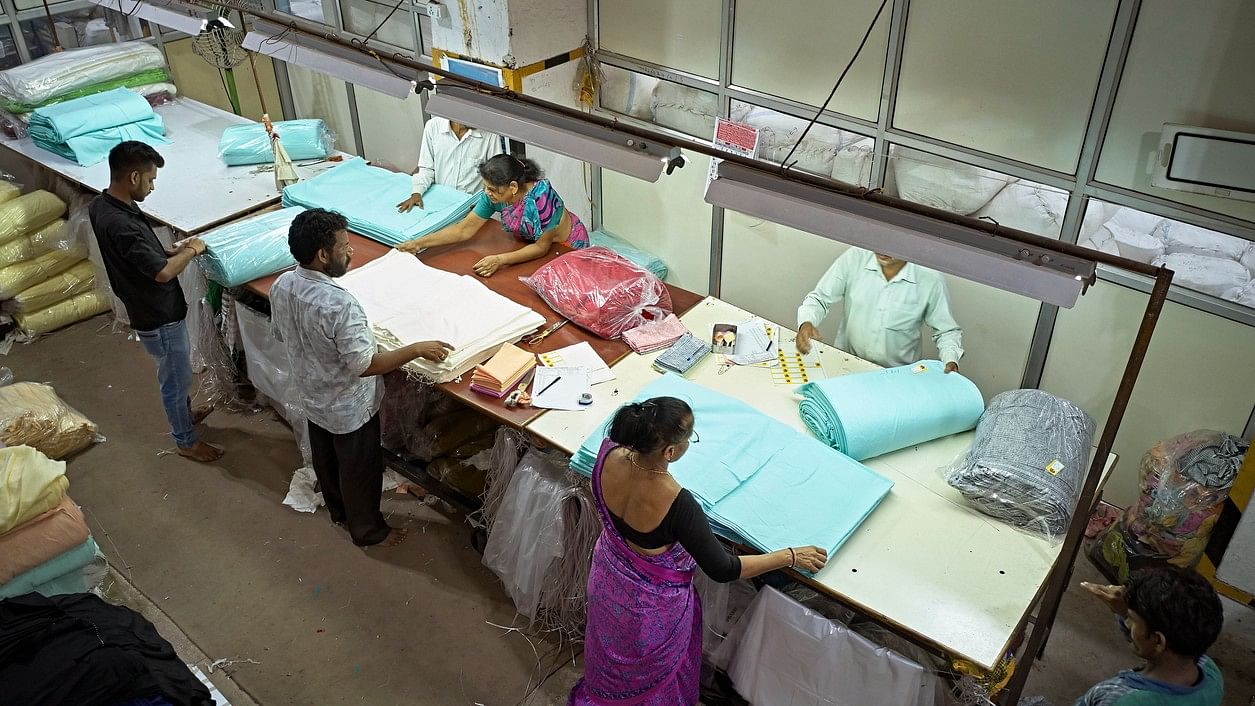
Workers folding and wrapping textiles in plastic on floor of dyeing and printing mill.
Credit: iStock Photo
The spotlight nowadays is invariably on sunrise industries like information technology (IT) and advanced technologies like artificial intelligence (AI) which are provoking global debates. Traditional industries that have been the backbone of India’s growth since Independence are not given much media space.
The textile sector, for instance, has receded into the background. Yet centuries ago, it was the fabric that put India on the world map. Even now, this country remains the fourth-largest textiles and apparel exporter and is the second-largest producer of jute, cotton, and silk.
It accounts for 95 per cent of the world’s handwoven fabric, and is the second-largest domestic employer with 45 million people directly dependent on it.
Yet the industry is not growing fast enough to match global competitors. So, the textile ministry’s recent announcement of a roadmap to virtually double its size can only be welcomed. It envisages an investment of Rs 70,000 crore in seven mega-integrated textile and apparel parts.
The current size of the industry is estimated at $164 billion which is expected to touch $350 billion by 2030. The focus will be on manmade fibres though natural fibres will also be given importance, according to the ministry.
The new policy comes in the backdrop of stagnation in textile and apparel exports in recent years. These had dipped by 3.2 per cent in 2023-2024 compared to the previous year.
The apparel sector has fallen far behind countries such as Vietnam, Bangladesh, and China on the world stage. Some studies place the blame on reliance on imported raw materials along with red tape in customs. In other words, Indian exports would otherwise be competitive, but bureaucratic procedures are a big constraint.
Another issue has been the challenging geopolitical scenario of the past two years. With nearly 27 per cent of apparel exports destined for the European Union and United States markets, the attacks by Yemen-based Houthis on merchant shipping going through the Red Sea have hit exports. Cargo ships are moving through the longer and more expensive route via the Cape of Good Hope, making Indian goods more expensive in key markets.
These developments have come along with the rising tariffs in the EU that have made Indian products lose ground to countries such as Bangladesh which benefit from the least developed country (LDC) tag. This is an issue sought to be raised by the textile industry in the ongoing free trade agreement negotiations with the EU as well as with the United Kingdom. The fact that textiles and apparel remain highly labour-intensive industries is an element that will have to be considered in the final agreement. This is in addition to the non-tariff barriers being imposed on environmental grounds on a wide range of products by the EU.
Technology upgradation is also urgently needed, especially since the sector is dominated by micro, small and medium enterprises (MSMEs) that need support for such growth.
Hand-holding will be needed if enterprises are to meet the EU’s environmental social and governance (ESG) goals. At the same time, exporters need to shift perspectives and try to diversify markets instead of relying heavily on Western countries.
As far as the Bangladesh crisis is concerned, it has had little beneficial impact despite expectations that supply disruptions could provide an opportunity for Indian apparel producers.
The reality is that several textile manufacturers had set up units in Bangladesh to avail of the EU’s concessional duties for the LDCs. These have been hit by the unrest while cotton yarn supplies to the neighbouring country are also reported to have slowed down.
On the domestic front, worries are rising over the dumping of Chinese man-made fibres into the country. This is despite tariffs as high as 24 per cent being levied on such imports. The new textiles roadmap will have to devise a way to protect indigenous industries from the impact of this development.
A more optimistic outlook has been projected by financial services agency B and K Securities that expects a recovery in exports by next year though domestic demand may continue to be moderate for the time being. A study on the sector has forecast that over the medium to long term, India could see more substantial gains as global buyers diversify supply chains away from China and Bangladesh.
Yet it is abundantly clear that the textiles sector needs closer attention, given its size and employment-intensive nature. Apart from exports, there are taxation issues related to the Goods and Services Tax (GST) that are a worry for the industry at all levels. Elimination of red tape also needs to be high on the policy agenda as India is losing ground to others in export markets.
The new roadmap is a step in the right direction, but it will be meaningful only if it can resolve the multiple issues facing this vast segment of the economy.
(Sushma Ramachandran is a senior journalist.)
Disclaimer: The views expressed above are the author's own. They do not necessarily reflect the views of DH.